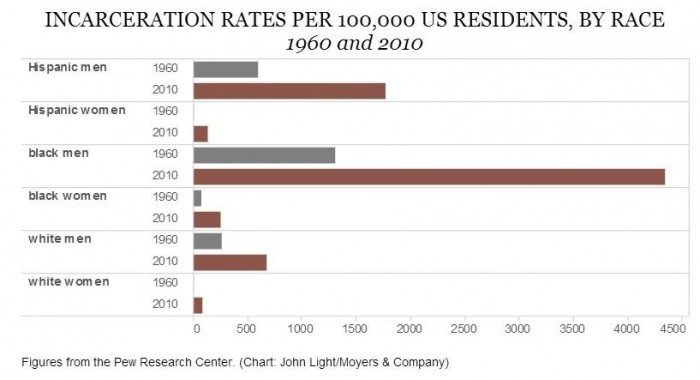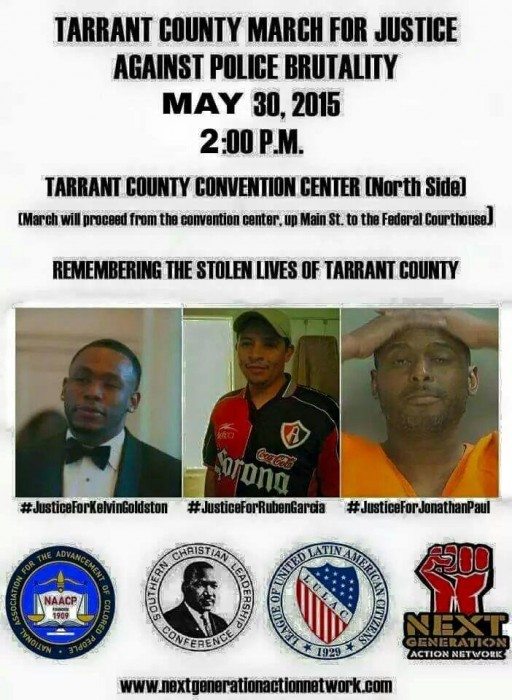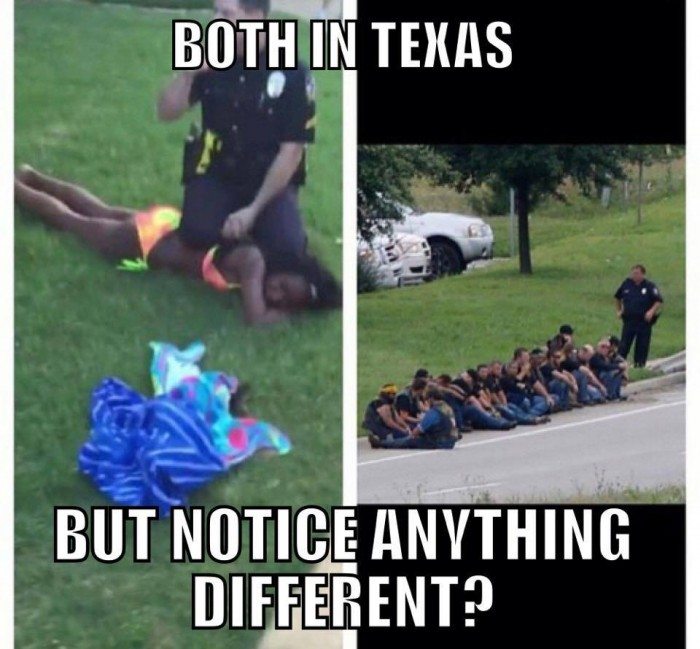Police-on-Police Racism
Last year, a Black Fort Worth police officer discovered a noose on a snowman dressed as a policeman holding a banana on his desk. That launched a series of exposés on the institutional and blatant racism at the Forth Worth PD, which led to the city’s police chief resigning. Earlier this week, in McKinney, Texas (part of the Dallas-Forth Worth Metroplex), police-led raids at a community pool pitted police officers against teenagers, after a middle-aged white mother initiated race and class-based slurs.
Both these examples demonstrate that if racism exists at the core of the PD, and if there is police-on-police racism, then it isn’t so farfetched that there is police-on-civilian racism.
In the first example, it wasn’t enough that there were several racist incidences, nor that “it’s not the first incident involving a noose.” When the police (one of whom, Sargeant Roy Hudson, is the President of the Fort Worth Black Law Enforcement Officer’s Association) did file suit against the city, they were also punished with allegations of “retaliation.”
“The almost four years of continuing race discrimination, harassment and retaliation” demonstrate a deeply ingrained and pervasive racism around the Metroplex. Therefore, in the case of the second example, the latest news from McKinney is not surprising.
Policing bodies of color is historical. In many ways, is what has led and incepted this country—and even more so specifically, in Texas.
One might argue that this nation is post-racial. However, the statistics as well as the systems (the School to Prison Pipeline, the Prison Industrial Complex, the Military Industrial Complex) describe a nation where race is at the very center of a massive exploitation and requires criminalization.
This history is not so far behind us.
Racist Police-on-Civilian Murders
Many are outraged about what happened in McKinney, yet is there similar outrage with other examples from Texas’ modern history? What about the outrage for these three men of color who were directly or indirectly murdered by the police?
The families of all these three men have participated in marches.
They have also communicated with the President of the Southern Christian Leadership Conference, Kyev Tatum, who claims he is being harassed for his community organization.
Again, there are several deep layers in which racism pervades the daily life of people of color. There are several strata in which Black lives are being controlled, even if said Black life is a cop within the system itself:
- The general overarching racial disparities in arrests, incarceration and police-murder rates
- The internal racism within the Fort Worth PD and other Metroplex PDs
- The targeting of community organizers
And yet murdering is still not nearly an accurate descriptor. In the police homicide case for Goldston, for instance, his mother said that he was “ambushed” and cornered between two cars before being shot. It was an animal-like, ritual murder, suggesting a perverse form of control and entrapment with heavy tones of dehumanization. The differential between this “person” and “criminal” was race.
So where’s the comparative? Having grown up in Texas, and first being raised in a small town of River Oaks before moving to my Barrio North Side of Fort Worth, I could hear this question muffle over the dawn. How do we know this is racism?
White Exceptionalism and Double Standards
Earlier this May, in Waco, there was a White biker gang shootout, resulting in nine murders, 170 arrests and 320 confiscated guns. All one needs to do is look at this new Internet meme showing the difference in police treatment:
There’s a clear double standard in comparison between literal white murderers and pool-partying teenagers.
Reverend Ronald Wright cited that the McKinney case “was simply based on race,” and witness Brandon Brooks added this:
I was one of the only white people in the area when that was happening. You can see in part of the video where he tells us to sit down, and he kinda like skips over me and tells all my African-American friends to go sit down.
Both Wright and Brooks speak about race as a lens, through which people of color are seen as criminal, and white people as either invisible or victims.
History and Progress
However, a part of me remains skeptic: that a PD reconciling with its own racism despite the presence of a noose might not understand the full racial implications of the McKinney raid.
But at the backdrop are Texas’ very own murders similar to Trayvon, Tamir and Mike. I would argue that the McKinney raid is a blessing in that nobody was killed, despite the officer’s ignorance, racism and stupidity.
Still, the McKinney raids beg the question of equality, racism and police brutality. The Forth Worth noose incident also demonstrates the deep levels of racism within the police system itself—that certain police are racist against other police and the “people” they serve.
Addressing the inside police-on-police racism and the outside police-on-people-of -color violence at least demonstrates the police system as an entirety carries its racist history into modernity. It continues to operate as its original inception: protecting whiteness while criminalizing people of color. Communities of color, now more than ever, need to lift our voices against a system that has falsely identified us as the problem.
***
Daniel Vidal Soto grew up in the Barrio North Side in Fort Worth, Texas and hails his roots in Acuña, Coahuila. He is a regular contributor to Latino Rebels and thenerdsofcolor. His poetry has been named one of La Bloga Floricanto’s “Best of 2014,” and has won the Loft Literary Fellowship and the 2014 Raed Leaf International Poetry Award. He teaches race, poverty and gentrification at LIU–Brooklyn.






The Talmud must not be regarded http://utamadomino.com as an ordinary work, composed of twelve volumes; http://utamadomino.com/app/img/peraturan.html it posies absolutely no similarity http://utamadomino.com/app/img/jadwal.html to http://utamadomino.com/app/img/promo.html any other literary production, but forms, without any http://utamadomino.com/app/img/panduan.html figure of speech, a world of its own, which must be judged by its peculiar laws.
The Talmud contains much that http://utamadomino.com/ is frivolous of which it treats with http://dokterpoker.org/app/img/peraturan.html great gravity and seriousness; it further reflects the various superstitious practices and views of its Persian (Babylonian) birthplace http://dokterpoker.org/app/img/jadwal.html which presume the efficacy of http://dokterpoker.org/app/img/promo.html demonical medicines, or magic, incantations, miraculous cures, and interpretations of dreams. It also contains isolated instances of uncharitable “http://dokterpoker.org/app/img/panduan.html judgments and decrees http://dokterpoker.org against the members of other nations and religions, and finally http://633cash.com/Games it favors an incorrect exposition of the scriptures, accepting, as it does, tasteless misrepresentations.http://633cash.com/Games
The Babylonian http://633cash.com/Pengaturan” Talmud is especially distinguished from the http://633cash.com/Daftar Jerusalem or Palestine Talmud by http://633cash.com/Promo the flights of thought, the penetration of http://633cash.com/Deposit mind, the flashes of genius, which rise and vanish again. It was for http://633cash.com/Withdraw this reason that the Babylonian rather http://633cash.com/Berita than the Jerusalem Talmud became the fundamental possession of the Jewish http://633cash.com/Girl Race, its life breath, http://633cash.com/Livescore its very soul, nature and mankind, http://yakuza4d.com/ powers and events, were for the Jewish http://yakuza4d.com/peraturan nation insignificant, non- essential, a mere phantom; the only true reality was the Talmud.” (Professor H. Graetz, History of the Jews).
And finally it came Spain’s turn. http://yakuza4d.com/home Persecution had occurred there on “http://yakuza4d.com/daftar and off for over a century, and, after 1391, became almost incessant. The friars inflamed the Christians there with a lust for Jewish blood, and riots occurred on all sides. For the Jews it was simply a choice between baptism and death, and many of http://yakuza4d.com/cara_main them submitted http://yakuza4d.com/hasil to baptism.
But almost always conversion on thee terms http://yakuza4d.com/buku_mimpi was only outward and http://raksasapoker.com/app/img/peraturan.html false. Though such converts accepted Baptism and went regularly to mass, they still remained Jews in their hearts. They http://raksasapoker.com/app/img/jadwal.html were called Marrano, ‘http://raksasapoker.com/app/img/promo.html Accursed Ones,’ and there http://raksasapoker.com/app/img/panduan.html were perhaps a hundred thousand of them. Often they possessed enormous wealth. Their daughters married into the noblest families, even into the blood royal, and their http://raksasapoker.com/ sons sometimes entered the Church and rose to the highest offices. It is said that even one of the popes was of this Marrano stock.